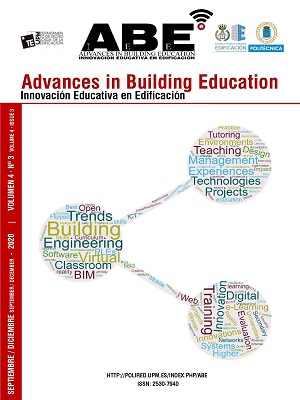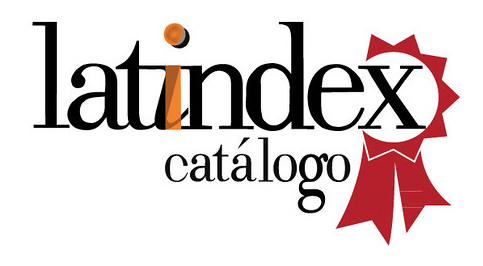BIM short course for construction industry professionals = Curso corto en BIM dirigido a los profesionales de la industria de la construcción
DOI:
https://doi.org/10.20868/abe.2020.3.4508Palabras clave:
BIM, training, professional course, construction industry, entrenamiento, corso profesional, industria de la construcciónResumen
The Building Information Modelling (BIM) methodology is currently the main work platform in the construction industry, and all sectors have been enhancing its applicability. The demonstration of the benefits registered in the development of various activities motivates the great interest. affirmed by architects, engineers and managers, in knowing its concept and the scope of its applicability. Recently, higher education technical schools have been following this interest, introducing changes into their curricular programs and also offering short courses to construction industry professionals. In recent years, the Department of Civil Engineering of the University of Lisbon, Portugal, has organized courses concerning BIM with the aim of meeting the professionals’ needs. To this end, the most recent short course offered to the technical community covered aspects, from the parametric modelling concept to the analysis of the interoperability capacity of the software. The text presents the course program - concept, practice, structures and construction - and the assessment of the degree of satisfaction of participants, based on their pre-course expectations and interest they had in attending the course. It can be concluded that the school and the industry should continue to collaborate in order to reinforce the efficiency of the construction sector.
Resumen
La metodología Building Information Modelling (BIM) es actualmente la principal plataforma de trabajo en la industria de la construcción, y todos los sectores han estado potenciando su aplicabilidad. La demostración de los beneficios registrados en el desarrollo de diversas actividades motiva el gran interés, verificado por arquitectos, ingenieros y gestores, por conocer su concepto y el alcance de su aplicabilidad. Las escuelas técnicas han estado siguiendo este interés, introduciendo cambios en sus programas curriculares y ofreciendo también cursos cortos a profesionales de la industria de la construcción. El Departamento de Ingeniería Civil de la Universidad de Lisboa, Portugal, ha estado organizando cursos sobre la cuestión BIM, en una perspectiva de lograr las necesidades de los profesionales. En este caso, el curso corto más reciente ofrecido a la comunidad técnica abarca varios aspectos, desde el concepto de modelado paramétrico hasta el análisis de la capacidad de interoperabilidad. El texto presenta el programa del curso (concepto, práctica, estructuras y construcción) y la evaluación del grado de satisfacción de los participantes, confrontado con sus expectativas e interés en asistir al curso. La escuela y la industria han estado colaborando para potenciar la eficiencia del sector de la construcción.
Descargas
Referencias
Eastman, C., Teicholz, P., Sacks, R., Liston, K. (2011) BIM Handbook: A Guide to Building Information Modelling for Owners, Managers, Architects, Engineers and Contractors, John Wiley & Sons, Inc., New Jersey, USA, 2011.
Chen, L.J., Luo, H. (2014) A BIM-based construction quality management model and its applications, Automation in Construction, 46, 64-73, doi.org/10.1016/j.autcon.2014.05.009
Barlish, K., Sullivan, K. (2012) How to measure the benefits of BIM: A case study approach, Automation in Construction, 24, 129-159, doi:10.1016/j.autcon.2012.02.008.
Sampaio, A.Z. (2017) BIM as a Computer-Aided Design methodology in Civil Engineering, Journal of Software Engineering and Applications, 10 (02), 194-210, doi: 10.4236/jsea.2017.102012.
Sampaio, A.Z (2020) Introduction of BIM methodology in Civil Engineering education: Curricular programs adaptation, STE 2020 - 1st International Conference on Science and Technology Education 2020, Porto, Portugal, 15-16 October 2020.
McAuley, B., Hore, A., West R. (2017) BICP Global BIM Study – Lessons for Ireland’s BIM Programme Published by Construction IT Alliance (CitA) Limited, 2017. doi: 10.21427/D7M049
Lozano-Díez, R.V., López-Zaldívar, O.,Herrero del Cura, S., Mayor, P.L. (2018) First experiences in the rule of the BIM environment: The case of the degree in Building of the Polytechnic University of Madrid, Advances in Building Education: Educative Innovation in buildings, 2 (1), 109-121, http://polired.upm.es/index.php/abe/article/view/4233
López Zaldívar, O.; Verdu Vázquez, A.; GilLopez, T.; Lozano Díez, R.V. (2017) The implementation of building Information Modeling technology in university teaching: The case of the Polytechnic University of Madrid. International Journal of Engineering Education 33(33-2).
Sampaio, A.Z. (2019) Proposal of curricular program to introduce BIM in a Civil Engineering school, book: Springer International Publishing AG, HELIX 2018, LNEE 505, Innovation, Engineering and Entrepreneurship, 1131–1137, 2019. doi.org/10.1007/978-3-319-91334-6_156.
Sampaio A.Z. (2017) BIM as a ComputerAided Design Methodology in Civil Engineering, Journal of Software Engineering and Applications,10,194-210, https://doi.org/10.4236/jsea.2017.102012
Faust, R. (2018) BIM curriculum development, AiC - 13th BIM Academic Symposium & Job Task Analysis Review, Autodesk University, Las Vegas NV, USA. https://dcp.ufl.edu/cacim/bim-education-2/
Saleeb, N., Dafoulas, G., Loomes, M.J. (2016) The role of architectural design in virtual worlds for educational purposes, 9th International Conference on ICT, Society and Human Beings (part of MCCSIS 2016: Multi Conference on Computer Science and Information Systems), Funchal, Portugal.
Peterson, F., Hatman, T., Fruchrer, R., Fischer, M. (2011) Teaching construction project management with BIM support: experience and lessons learned, Automation in Construction, 20 (2), 115-125, https://doi.org/10.1016/j.autcon.2010.09.009
Oliveira, J.D., Sampaio, A.Z. (2019) BIM in structures: analysis of interoperability, ICSAAM2019 International Conference on Structural Analysis of Advanced Materials, Ischia, Italy.
Mota C., Sampaio, A.Z. (2016) BIM model of structures used in construction planning, National Meeting of Structural Concrete, Coimbra, Portugal, 10 pgs,. http://be2016.dec.uc.pt/
Araújo, L. (2016) Development of a wall library in BIM methodology, Master's thesis in construction, University of Lisbon, Lisbon, Portugal.
Serra, P., (2019) Application of BIM methodology in infrastructure, short course BIM methodology in the Construction industry, University of Lisbon, Lisbon, Portugal.
Descargas
Publicado
Número
Sección
Licencia
Derechos de autor 2021 Autor / BY-NC-ND

Esta obra está bajo una licencia internacional Creative Commons Atribución-NoComercial-SinDerivadas 4.0.
ABE (Advances in Building Education / Innovación Educativa en la Edificación) no aplica cargo alguno a los autores por procesar o publicar un artículo y provee acceso abierto (Open Access) inmediato a su contenido. Todo el contenido está disponible gratuitamente sin cargo para el usuario o su institución. Se permite a los usuarios leer, descargar, copiar, distribuir, imprimir, buscar o vincular a los textos completos de los artículos, o utilizarlos para cualquier otro propósito lícito, sin pedir permiso previo del editor o el autor. Esto está de acuerdo con la definición de acceso abierto de la BOAI.
1. Los autores conservan los derechos de autor y garantizan a la revista el derecho de una Licencia Creative Commons Atribución / No Comercial / No Derivadas 4.0 Internacional (CC BY NC ND) que permite a otros compartir el trabajo con un reconocimiento de la autoría y uso no comercial.
2. Los autores pueden establecer por separado acuerdos adicionales para la distribución no exclusiva de la versión de la obra publicada en la revista (por ejemplo, situarlo en un repositorio institucional o publicarlo en un libro).
Salvo indicación contraria, todos los contenidos de la edición electrónica se distribuyen bajo una licencia de uso y distribución “Creative Commons".














